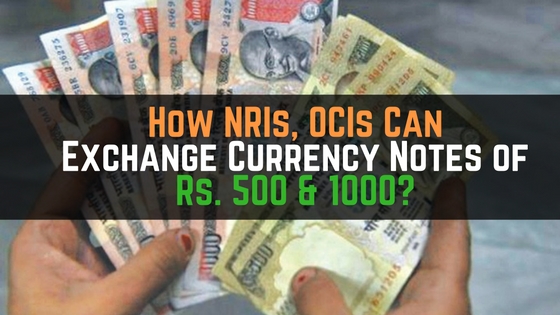Currency Notes of Rupees 500 & 1000 ‘Banned’!
Non-residents of India (NRIs), Person of Indian Origin (PIO) and Overseas Citizen of India (OCI) must be at unrest these days. The sudden declamation from PM Narendra Modi interprets that denomination of INR 500 and INR 1000 would no more be a legal tender since 9th November, 2016.
The Indian diaspora abroad is in critical situation. Withdrawal of funds has been strictly restricted to INR 20,000 per week for it. Moreover, only INR 5000 can be exchanged from foreign exchange counter at airport.
‘Limit’ for Cash- Deposit!
Those who have parked currency notes of the foretold denomination can deposit as well as exchange from their respective banks. It’s an effort to bring black money in light. Those who have parked Indian currency in abundance at their home must have to either deposit or exchange.
According to the recent announcement, the funds upto INR 2.5 lakh can be deposited without disclosing its source. It would be considered as white money. But if the depositing amount exceeds this limit, the person must have to disclose its source along. Then only, he/she shall be exempted from any legal action and penalty.
‘Penalty’ for Parking Black Money
Those who fail to produce source of parking amount shall be penalized under benami law. The quantum of penalty is fixed, i.e. 200% of the unaccounted money. Also, the person can be jailed for one to seven years.
‘Limit’ for Cash-Withdrawal!
Since banks and ATMs are running out of cash, Indian government has decided to frame certain limit for cash withdrawal. A person can fill the withdrawal form worth INR 10,000 and get it easily. But the maximum limit is set, i.e. INR 20,000 from his/her bank in a week.
And this limit has been shortened for dispensing amount through ATM kiosks. Only INR 2500 can be dispensed per day by an individual from the ATM of any bank. And if the person withdraws from another bank’s ATM, the limit will be INR 2,000 only. For example, if I am an SBI account holder, I can withdraw INR 2,500 from its kiosk. But if I do the same from HDFC’s kiosk, I can get only INR 2,000.
Now, 2500 petrol pumps are aligned for catering convenience. People can swipe their SBI card from their swiping machine and take away upto INR 2000 to their home. Very soon, the number of such petrol pumps will be around 20,000.
‘Limit’ for Exchanging Indian Currency Notes
Every person of this origin can exchange old currency note from 9th November, 2016. Like deposit and withdrawing limit, the mount to be exchanged shall not be more than rupees 4,000 per day.
Steps to Exchange Indian Currency with Foreign Currency:
- Go to the bank where you have NRE or NRO account.
- Fill an application form to exchange money. The guidelines of each bank may vary. So, please read carefully before filling it.
- Enclose identity proof like Nativity Certificate or PAN card or OCI card. Confirm it with the bank which documents do they accept.
- Take original as well as photocopy of the original docs also.
Foreign tourists can exchange their banned currency from any bank. For them, the limit is upto INR 5,000. At bank, they have to follow the same procedure as told above. They have to take along their identity proof.
How NRIs can exchange INR from foreign country, like US, UK, UAE and Dubai etc.?
By four ways:
- In-person visit Indian or Foreign Banks
- Through NRO account
- From RBI’s exchange counters
- Through Authority Letter
How can they deposit from Indian or foreign bank of US, UK, UAE and Dubai etc.?
- Visit bank with desirable INR
- Show passport, visa, PAN card, debit card details & address proof of the resident country
- Show evidence of its source
- Get exchanged amount.
- The foreign banks will deduct @ conversion rate.
How can they exchange from India while being in US, UK, UAE and Dubai etc.?
- Get ‘Authority Letter’ form from bank in India on mail from your relatives.
- Fill it.
- Courier or fax it with your bank details, identity proof, passport and PAN card.
- Inform the authorized person to take his/her own identity proofs and your authority letter along with.
- When he/she deposits, get the amount transferred through e-conduits like Paypal and Paytm.
- Withdraw the amount through your NRO account.
How can NRIs exchange INR from Reserve Bank of India (RBI)?
- Fly down to India.
- Visit regional office of RBI with old denomination.
- Take along the valid identity proofs (like PAN card, passport, Aadhaar card & visa).
- Show bank details, like debit card number and CVV no.
- Show the source of that currency.
- Deposit the amount.
- Withdraw only INR 10,000 per day & INR 20,000 per week.
The above mentioned directions are directed by the honourable Indian government on 9th Nov. 2016. These directions are likely to be changed in future. So, stay tuned with the latest update regarding demonetization in our upcoming blogs.











